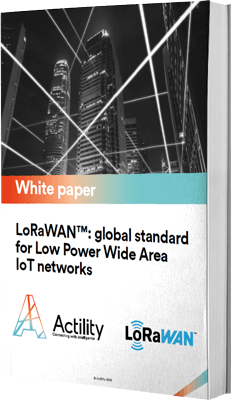In 2015, the Abeeway founders observed that there were no tracking and location devices in the market offering decent autonomy without oversized batteries or infringed precision of location.
We have to remember that GPS works with a constellation of satellites continuously broadcasting a radio signal that a receiver intercepts to determine the ephemeris as well as the distance to each visible satellite, allowing to calculate the receiver’s position. Translated to an IoT sensor, it means that all the processing is made by the chipset, which requires a lot of processing time and therefore energy.
It became clear that reducing the sensors’ energy consumption would be instrumental to enable large-scale IoT location and tracking.
“When I joined as CTO, I committed with my team to improving GPS efficiency to overcome this technical hurdle.” Stéphane Boudaud, Actility
Based on extensive field tests starting in 2016, we decided to tackle the power consumption of the GPS positioning – knowing that it is the most energy-consuming element of a tracker.
The second reason for optimizing the GPS processing and connectivity was to accommodate the emerging LoRaWAN standard with specific data transfer requirements such as low data rate and limiting downlink packets. In addition, since low-cost IoT endpoints have limited processing power, GPS calculations had to take place outside the device, in the cloud.
“The technical challenge was to find the right way to transmit minimum information via LoRaWAN while enabling maximum results on the server.”
After half a year of intense development, we had a functional solution up and running! Abeeway registered a patent for Low Power GPS in July 2016, an optimized GPS location process, designed for LPWA networks, and more specifically for LoRaWAN. In the meantime, the team continued to improve the precision of location, power consumption and time to first fix.
A-GPS optimized for LPWA networks
The satellite data collected by the GPS device (the ephemeris and the almanac) are already preloaded on the server. In that case, the GPS receiver only collects raw data from satellites, then transmits it to Abeeway location assistance server via the LoRaWAN network.
The server combines this information with known satellites trajectories and calculates the final position. The whole process is made in the cloud, which is much faster than inside the device and does not waste its energy for calculation.
“As a result, Low Power GPS allows reducing energy consumption up to 10 times while maintaining high location accuracy.”
When a standalone GPS receiver has to get its first position (its “first fix”), it needs a signal strong enough to do it. LP GPS allows overturning this acquisition sensitivity constraint with the ability to extract raw data and calculate a position on the cloud.
“Where GPS fails, LP GPS will still provide a position, with an accuracy depending on a number of satellites in reach.”
In a nutshell, Low Power GPS devices offer:
Test packages for Low Power Location are soon available, book yours!
Inscrivez-vous à notre webinaire :
Nouvelle étape dans l’intégration des services urbains via LoRaWAN®
28 novembre 2024 – 10:00 (CET)







Learn more about the LoRaWAN technology by downloading the Actility “What is LoRaWAN” white paper